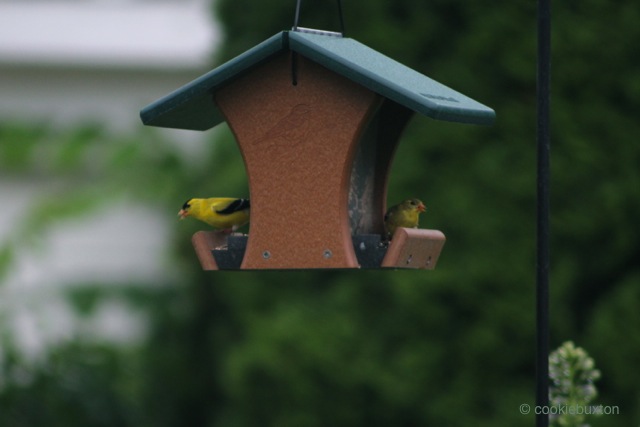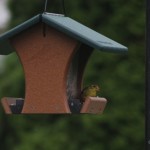Goldfinch Pair Pay a Visit
Two days after changing the feed in my bird feeder from low grade generic brand to premium songbird feed, a pair of songbirds – Goldfinches – showed up at the feeder. I have not spotted them in my neighbourhood prior to today, but they are undoubtedly at home in the urban district. The delightful outcome of seeing them so soon after a change in feed was well worth the few extra dollars paid for the seed.
In my part of the world, within the Great Plains region south and west of the Boreal forest, the American Goldfinch (Carduelis tristis) makes itself at home in meadows and fields across the southern third of Manitoba. In cities, it is common to see Goldfinch in areas with well stocked bird feeders and thistle and dandelions growing nearby.
Mating pairs reproduce in compact nests in deciduous trees and shrubs towards the end of June, when food supplies become more reliable. This pair likely have a nest nearby. My district has a fair collection of maples, birch, hawthorn shrubs, and other tall shrubs that these birds frequent. There are thistles maturing along one side of my garage, and a fair supply of dandelions in the back lane, both of which are good sources of nutrients for the Goldfinch to feed to its young.
There are several types of yellow birds in Canada. The handsome and boldly marked Goldfinch with its bright yellow head, back, and belly is a welcome sight. The male sports a distinctive black cap that extends from its beak, above the eyes, and on to its forehead. The black colouring on the wings of both the male and the female is punctuated by two sets of white wing bars, and the male has white undertail colouring. The female, in contrast with the male’s bright colour, is a dullish yellow, and she lacks the black cap of the male. The tail on both male and female is dark in colour.
During the winter period, which the birds spend in the mid- to southern regions of North America, the yellow colouring of both male and female Goldfinches becomes a dull yellow.
As you will see in the photographs, the orange-yellow beak on the Goldfinch is short and cone-shaped (conical).
With thistle growing nearby and sunflower seeds in the feeder, we may be able to watch these birds throughout the summer. Hopefully, once they are hatched, the young will stick around for a few weeks’ time.
There are drawings online that are useful in identifying this species: visit the National Geographic website to view.
Helpful field guides relating to northern birds:
Lone Pine – Manitoba Birds
The Roger Tory Peterson – A Field Guide to the Birds
The Audubon Society – Field Guide to North American Birds
Photos and Text: NK
Photo location: Home Garden, Winnipeg (2015)
Copyright: N.Kampen/cookiebuxton
Photo Gallery
Click on any image to enlarge, and click again on the photograph to advance through the series.







